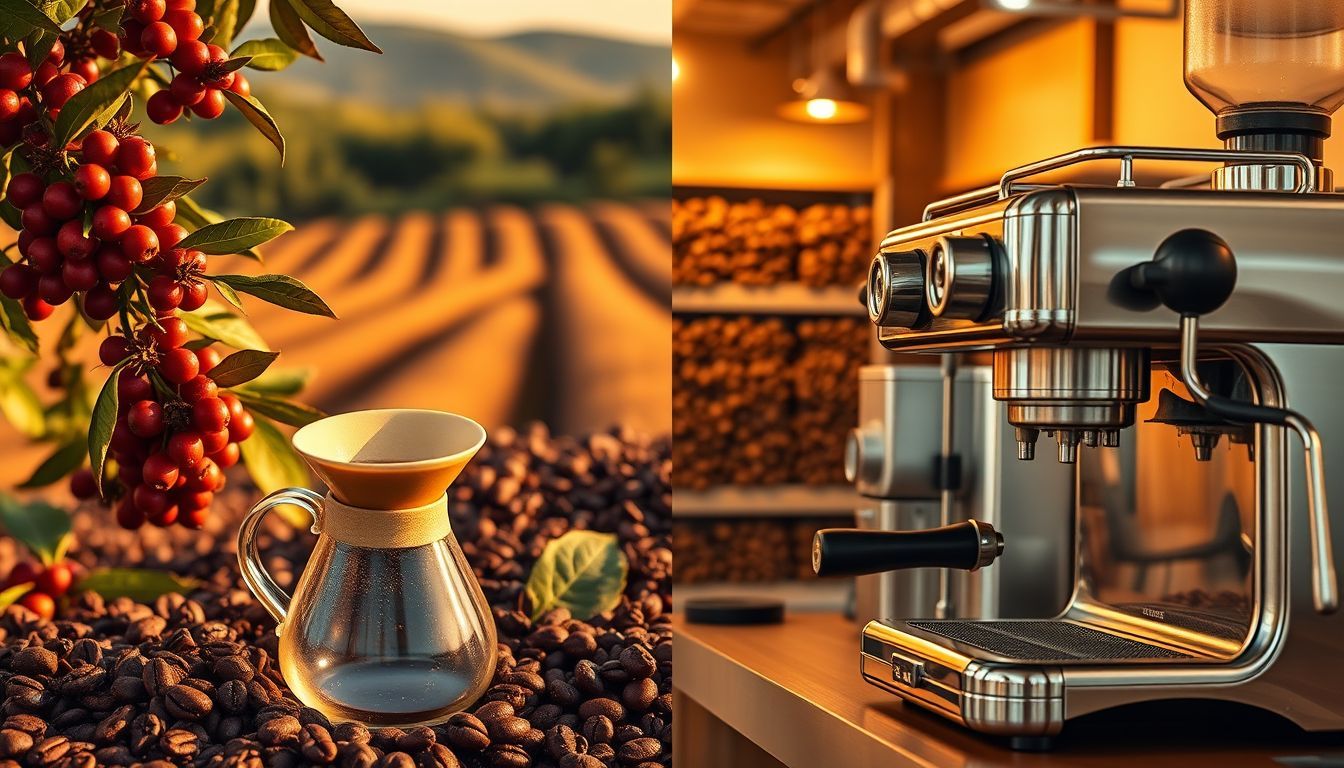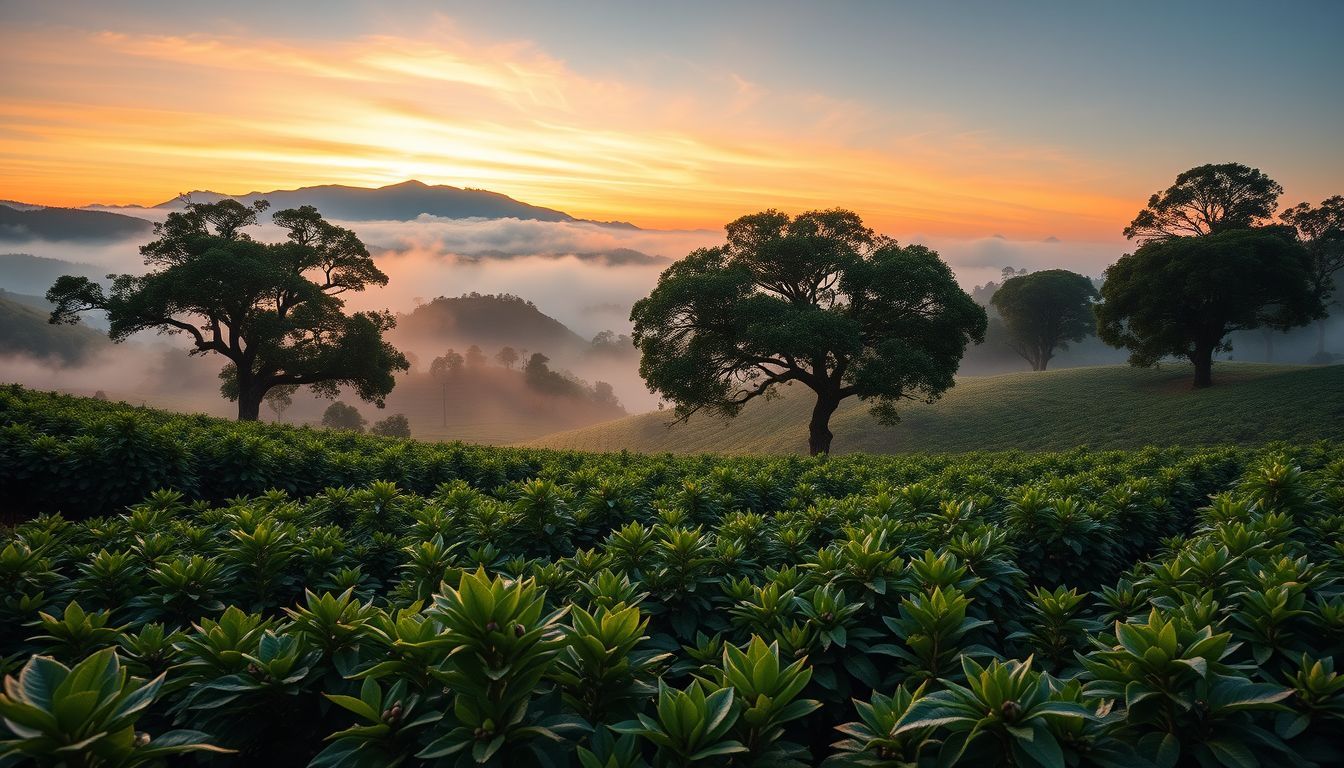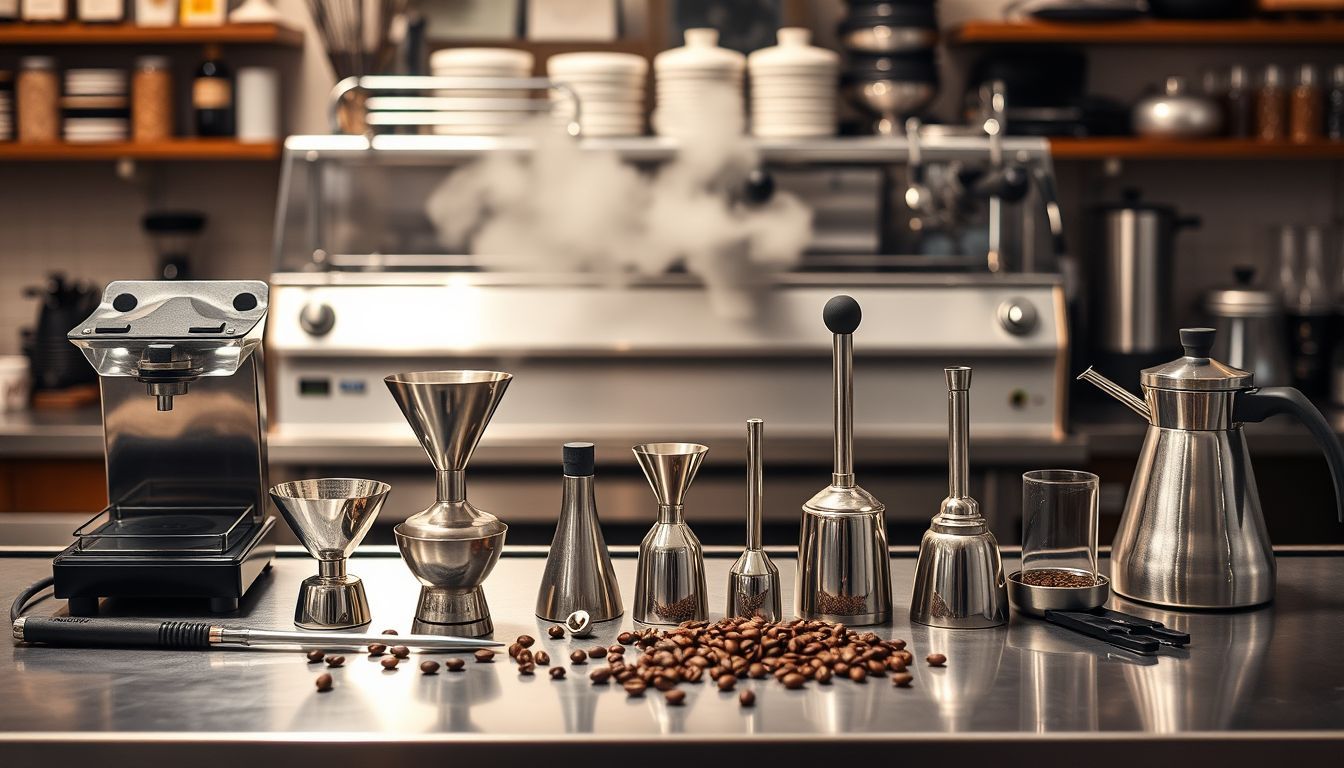Single Origin vs Blends: Understanding Coffee Sourcing and How It Affects Your Cup
Journey through the profound differences between single origin and blended coffees, discovering how terroir, processing, and seasonal rhythms shape every sip in your cup.

Amazon Affiliate Disclosure
This post contains affiliate links. If you purchase through these links, we may earn a small commission at no additional cost to you.
In the quiet moments before dawn, when the world still holds its breath, coffee farmers across the globe begin their daily pilgrimage through rows of emerald bushes heavy with crimson cherries. Each farm, each hillside, each microclimate whispers its own story into the beans—stories that eventually find their way to your morning cup. But how these stories reach you depends on a fundamental choice in coffee sourcing: the path of the single origin or the symphony of the blend.
As someone who has walked the volcanic slopes of Guatemala at sunrise and felt the misty embrace of Ethiopian highlands, I've come to understand that choosing between single origin and blended coffee isn't merely about preference—it's about connecting with the very soul of where coffee comes from.
The Poetry of Place: Understanding Single Origin Coffee
What Makes Coffee "Single Origin"
Single origin coffee is like a solo performance by a master musician—pure, unadorned, and deeply expressive of its source. These coffees come from one specific location, whether that's a single farm, a particular region, or even a specific lot within a farm. When you hold a bag of single origin coffee, you're holding the concentrated essence of a place.
The beauty of single origin lies in its transparency. Every characteristic in your cup—the bright acidity reminiscent of green apples, the floral notes that dance on your palate, the earthy undertones that ground you—can be traced back to specific environmental factors, processing decisions, and the skilled hands that nurtured those beans from seed to cup.
The Language of Terroir
Terroir—that beautiful French concept borrowed from wine—speaks to how environment shapes flavor. In coffee, terroir encompasses everything from altitude and soil composition to rainfall patterns and the angle of morning sunlight hitting the mountainside.
I remember standing in a coffee farm in Huila, Colombia, at 1,800 meters above sea level, where the thin air and intense UV radiation stress the coffee plants just enough to concentrate their flavors into something extraordinary. The resulting cup carried notes of dark chocolate and orange zest—a direct translation of that specific place and moment in time.
High-altitude coffees often develop more complex acidity and floral characteristics, while lower-altitude farms might produce beans with fuller body and earthier notes. Volcanic soils impart mineral complexity, while the daily temperature fluctuations in mountainous regions slow the cherry maturation, allowing sugars to develop more fully.
Processing: The Final Chapter of Origin
The processing method—how the coffee cherry transforms into the green bean—adds another layer to the single origin story. Whether the farmer chooses washed, natural, or honey processing dramatically affects the final flavor profile.
Natural processing, where cherries dry with the fruit intact, often creates wine-like and fruit-forward flavors that can be polarizing but unforgettable. Washed processing strips away the fruit to highlight the bean's inherent characteristics—the truest expression of varietal and terroir. Honey processing walks the line between both, creating complexity through controlled fermentation.
The Art of Harmony: Understanding Coffee Blends
The Master Blender's Canvas
If single origins are solo performances, then blends are symphonies—carefully orchestrated combinations where each component plays a specific role in creating something greater than the sum of its parts. Master blenders are like conductors, understanding how different origins complement, contrast, and enhance each other.
A skilled blender might use an Ethiopian coffee to add floral top notes, anchor the blend with a full-bodied Brazilian base, and introduce a Guatemalan component for chocolate undertones and structural complexity. The goal isn't to mask individual characteristics but to create harmony—a balanced cup that remains consistent throughout the year.
Consistency Across Seasons
One of the greatest challenges in coffee is seasonality. Coffee harvests happen at different times around the world, and even the same farm can produce dramatically different flavors from year to year based on weather patterns, processing variations, and countless other factors.
Blends solve this challenge by providing consistency. When the Ethiopian component of a blend becomes unavailable or changes character, a skilled blender can adjust ratios or substitute similar origins to maintain the blend's signature profile. This consistency is why many cafes and roasters rely on blends for their espresso—customers expect their daily cappuccino to taste the same whether it's January or July.
The Economics of Accessibility
Blends also make exceptional coffee more accessible. While a limited-lot single origin from a renowned farm might cost $25 per pound, a thoughtfully crafted blend can deliver complexity and satisfaction at a more approachable price point by combining premium origins with solid, less expensive components.
Seasonal Rhythms and Availability
The Coffee Calendar
Coffee follows the rhythms of the earth, with harvest seasons varying by hemisphere and region. Central and South American coffees typically harvest from October through March, while East African coffees peak from October through January. This natural cycle means that truly fresh single origins are only available at certain times of the year.
I've learned to anticipate these rhythms—the excitement of new crop Kenyan coffees arriving in late winter, the anticipation of fresh Colombian beans in early spring. There's something deeply satisfying about drinking coffee that was growing on a tree just months ago, still carrying the energy of its recent harvest.
The Patience of Aging
Some single origins benefit from rest after roasting, developing complexity over weeks or even months. Others shine brightest in their first flush of freshness. Understanding these patterns helps you appreciate single origins at their peak expression.
Blends, by contrast, are typically designed for immediate enjoyment and consistent performance across their shelf life.
Flavor Traceability: Following the Thread
The Single Origin Story
With single origins, every flavor note tells a story you can trace. That wine-like acidity in your Ethiopian Yirgacheffe? It comes from the specific heirloom varietals grown in that region, the high altitude, and the traditional washed processing. The chocolate notes in your Guatemalan Antigua? Thank the volcanic soil and the careful shade-growing practices.
This traceability creates a deeper connection between drinker and origin. You're not just consuming caffeine—you're experiencing a specific place, time, and tradition.
The Blend's Complex Narrative
Blends tell more complex stories—narratives woven from multiple origins, each contributing its voice to the final composition. A well-crafted blend might combine the brightness of a Kenyan AA with the body of a Sumatran Mandheling and the sweetness of a Brazilian Pulped Natural, creating flavor combinations that no single origin could achieve alone.
Choosing Your Path: Brewing Methods and Personal Preference
Single Origins and Brewing Synergy
Single origins often shine brightest when paired with brewing methods that highlight their unique characteristics. A floral Ethiopian coffee might sing in a pour-over that emphasizes clarity and brightness—especially when brewed with a Hario V60 Ceramic Coffee Dripper, Size 02, White.
(affiliate link: Hario V60 Ceramic Coffee Dripper, Size 02, White)
For immersion methods, a robust, earthy Sumatra will develop beautifully in a French press—consider the MuellerLiving French Press Coffee Maker for a classic experience.
(affiliate link: MuellerLiving French Press Coffee Maker, 34oz)
Blends and Versatility
Blends are often designed for versatility, performing well across multiple brewing methods. Espresso blends, in particular, are crafted to create balanced shots with good crema, sweetness, and complexity—characteristics that translate well into milk-based drinks in machines like the Cuisinart 12-Cup Coffee Maker with Thermal Coffee Carafe.
(affiliate link: Cuisinart 12-Cup Coffee Maker with Thermal Coffee Carafe)
Many blends work beautifully as both espresso and drip coffee, making them practical choices for households with varied brewing preferences.
Developing Your Palate
If you're beginning your coffee journey, single origins offer an education in how origin affects flavor. Tasting coffees from different regions side by side reveals the impact of terroir, processing, and varietal selection. Start with coffees from major growing regions—perhaps a bright Kenyan, a chocolatey Guatemalan, and a wine-like Ethiopian—to understand the spectrum of coffee flavors.
Blends, meanwhile, teach you about balance and harmony. They show how different flavor components can work together, creating complexity through combination rather than isolation.
To measure your coffee like a pro, a precision scale is invaluable. The KitchenTour Coffee Scale with Timer provides the accuracy you need for consistent extraction every time.
(affiliate link: KitchenTour Coffee Scale with Timer)
The Rhythm of Coffee Seasons
Embracing Impermanence
One of the most beautiful aspects of single origin coffee is its impermanence. That exceptional lot from a small farm in Honduras might only be available for a few months. This scarcity creates urgency and appreciation—when you find a single origin that speaks to you, savor it fully, knowing it may never exist again in quite the same way.
This impermanence mirrors the natural world from which coffee comes. Just as no two sunsets are identical, no two harvests produce exactly the same flavors.
The Comfort of Consistency
Blends offer a different kind of beauty—the comfort of consistency, the reliability of a familiar flavor profile that welcomes you home each morning. There's profound value in having a coffee that tastes like itself, day after day, season after season.
Conclusion: Finding Your Coffee Truth
As I write this, steam rises from my cup—a single origin from a small farm in Nariño, Colombia, where I once watched the sunrise paint the mountains gold. In this cup, I taste not just coffee, but memory, place, and the dedication of farmers whose names I know.
Yet tomorrow, I might choose a carefully crafted blend that tells a different story—one of harmony, balance, and the art of combination. Both choices are valid, both are beautiful, and both connect us to the vast, complex world of coffee.
The choice between single origin and blend isn't about right or wrong—it's about what speaks to you in any given moment. Perhaps you crave the adventure of exploring new origins, the excitement of tasting coffee that captures lightning in a bottle. Or maybe you seek the comfort of consistency, the satisfaction of a perfectly balanced cup that never disappoints.
In the end, the best coffee is the one that brings you joy, whether it carries the pure voice of a single place or the harmonious chorus of a thoughtful blend. Both paths lead to the same destination: a deeper appreciation for the remarkable journey from seed to cup, and the countless hands and hearts that make each sip possible.
Trust your palate, embrace curiosity, and remember that every cup is an opportunity to connect with the beautiful, complex world of coffee—one sip at a time.

Ben Carter
I spent the first part of my life learning the language of the wild—the rustle of leaves, the silence of snow, the resilience of a lone tree. In my writing, I try to translate that language, exploring how the landscapes around us shape the landscapes within us. My stories are quiet, but I hope they speak to a deeper part of you.


